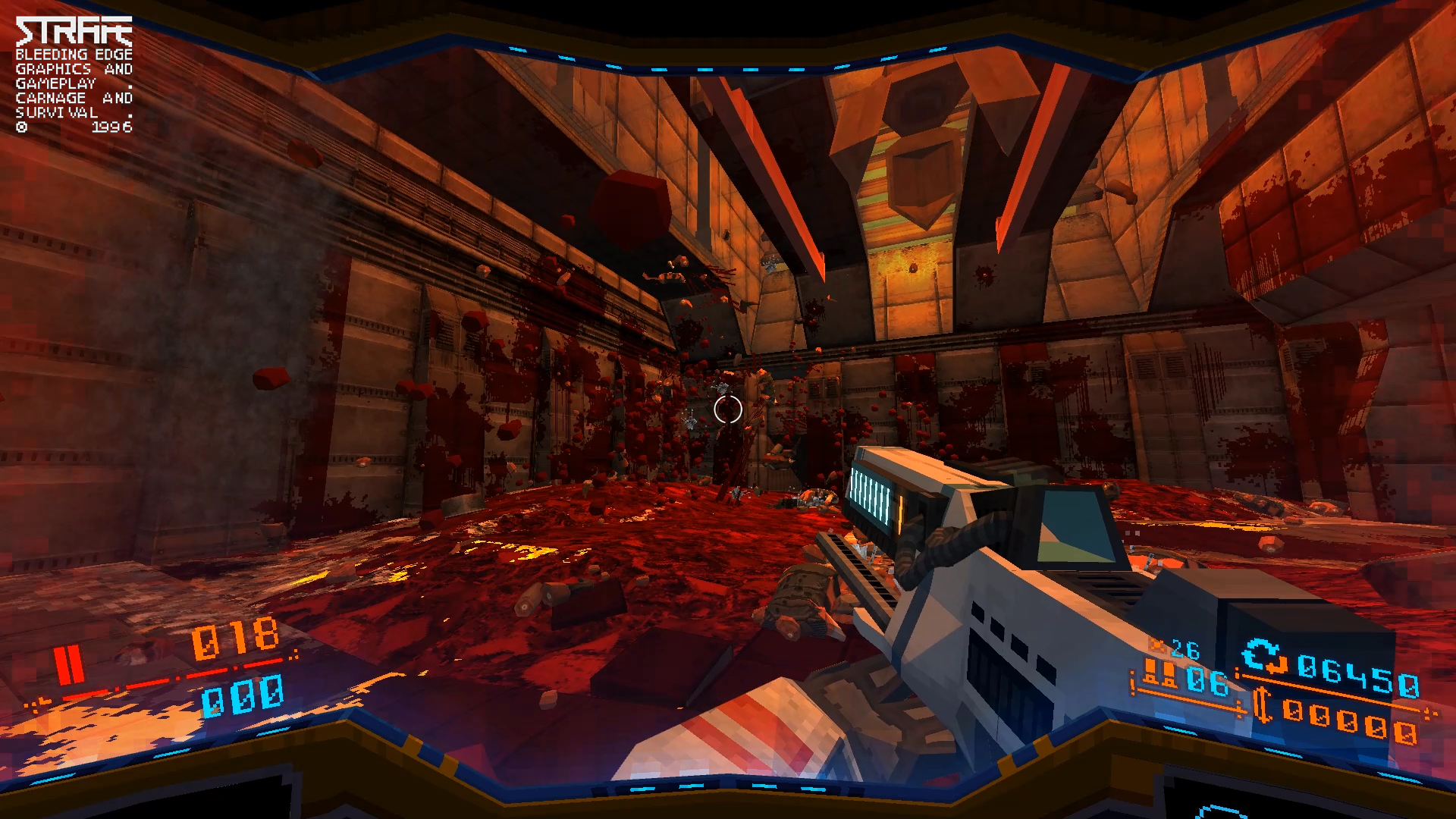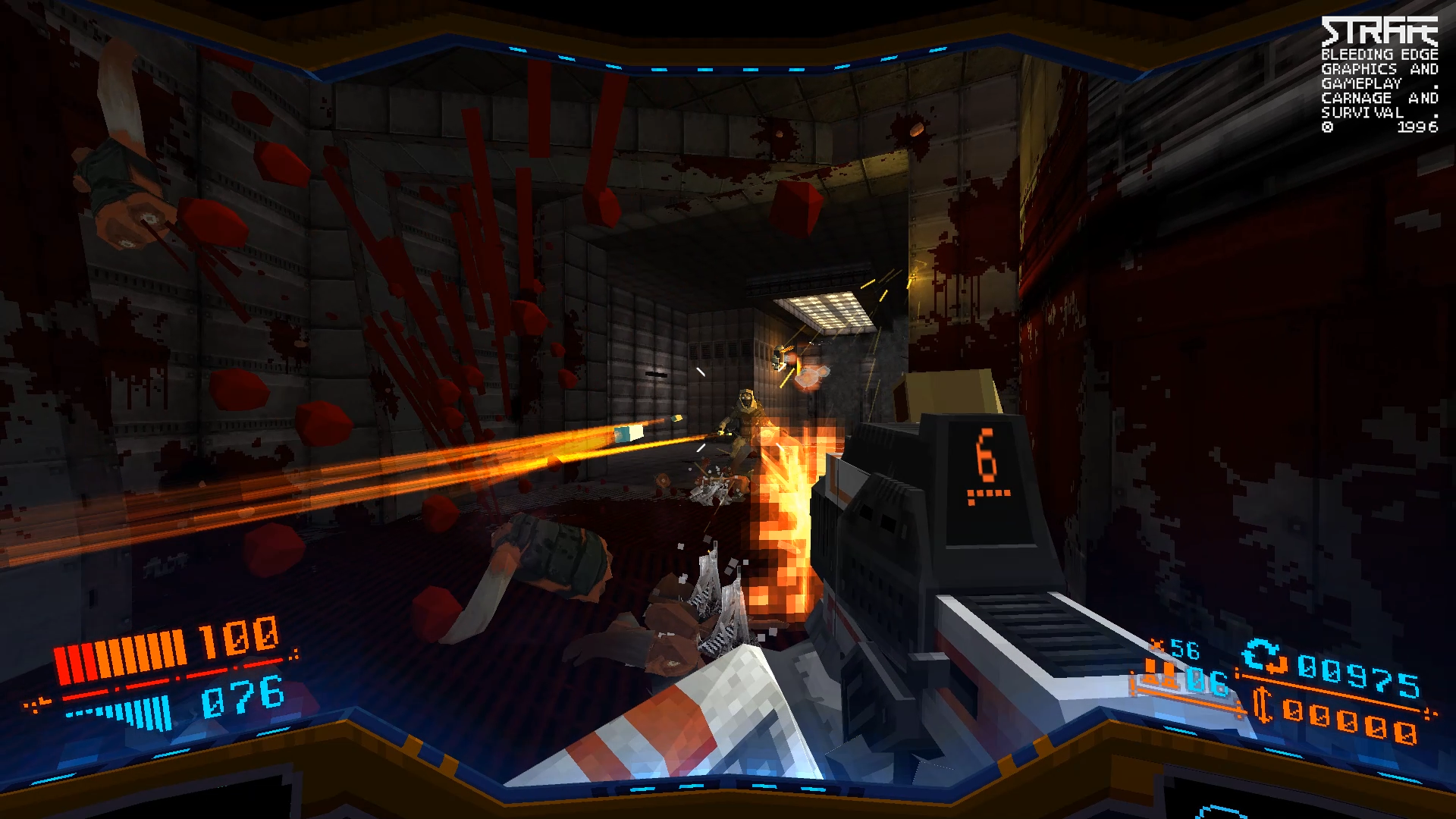The FPS inspired by Quake, Spelunky, and the '90s
Strafe strives to parody Quake while being more than just a nostalgia trip.

“Play the tutorial,” says Strafe creator Thom Glunt. He steps in so I can hear him over the racket on the QuakeCon expo floor. “It’s FMV.”
Full motion video, the awful bastard spawn of ‘80s arcade cabinets and ‘90s CD-ROM file sizes, is the perfect choice for Strafe. The Quake 2-inspired ‘90s shooter probably wouldn’t even be on my radar without its series of excellent live-action trailers. The trailers are expertly produced and drip with more ‘90s raditude than the entire cast of Friends playing with finger skateboards.
Strafe's tutorial is in the style of a low-budget workplace training video, and it’s breathtaking. Weird smash-cuts drag the tone all over the place, and I see the tip of a boom mic dip into frame. It is hilarious and, Glunt says, the only narrative element in Strafe.
After the walkthrough, I select the shotgun and start blasting stuff. Barrels, aliens, power-ups. I shoot them all. Controls in Strafe are familiar—shooting and reloading are as comfortable as an old sweater. I unlock a grenade launcher and immediately arc an explosive right into a bad-guy’s face. It’s my lone moment of heroism, because I die very quickly.
If that’s the whole story, Strafe would be pretty average. It’s like Quake, but Quake is like Quake too, only better at it. But Strafe is a roguelike. It features permadeath, procedurally generated levels, and randomized spawns. Glunt came up with the idea after falling deeply in love with Spelunky in 2014. In fact, it’s Spelunky’s name, not Quake’s, that comes up most often in our conversation.
The thing that sucked me into Spelunky is the way it rewards high-skill play.
Like Spelunky, Strafe is divided into themed zones, each made up of multiple procedurally generated levels. Building a Quake roguelike solved a problem for Glunt—he loved playing Quake 2, but he’d memorized the game. Strafe will snap together levels, randomizing interior geometry, size, and orientation, then connecting to other random rooms to make up a level.
“The thing that sucked me into Spelunky is the way it rewards high-skill play. They don’t force you to buy your way to get to the end of the game, and you don’t have to level up your character and grind points to have a chance.” Strafe will keep a high level of difficulty that is conquerable only through growing player expertise. A skilled player should be able to finish a run in around 90 minutes.
The biggest gaming news, reviews and hardware deals
Keep up to date with the most important stories and the best deals, as picked by the PC Gamer team.
Up until Strafe’s successful Kickstarter, Thom’s day job was in directing commercials and music videos. These skills went straight to work making the web videos that were so successful at generating attention.
“Our goal when we made the first spot was to make something that fit the period and the theme,” Glunt says. “We thought, ‘what if we made a ‘90s commercial and made it ridiculous?’ And it works because even when you did that, it would feel authentic because the ‘90s were ridiculous.”

Talking to Thom is like talking to an interactive encyclopedia of classic game mechanics. He’s smart, and he has opinions. He gets philosophical on why players will be given one weapon at a time: “The point is to have ownership of one weapon, and to feel like you’re upgrading it until it becomes an extension of yourself.” He rapidly name-drops original Quake maps.
There’s something bothering me about the sense of ironic detachment I got from the FMV tutorial, so I tell him that. Is this just another nostalgia movie remake? He shakes his head, “It’s loving satire.” We start debating the merits of parody, remakes, and the comedy homages of Edgar Wright. Like Shaun of the Dead riffing on Dawn of the Dead, there’s a thin line between homage and parody. Is Strafe just Funny Quake?
“I love comedy and attitude, but I don't want the game to come off like that,” Glunt says. “Jokes and humor are fun, but with games being replayable, those things become painful to sit through.” The team decided early to get all of the laughs out in the game’s marketing and never let it touch the game itself. “It was a conscious choice to make the game a sincere experience.”
It may be sincere, but Strafe itself is nonetheless a parody. “The secret is knowing something well enough to know what to make fun of,” Glunt says. He brings the conversation back to Edgar Wright. “Hot Fuzz! How does he make Hot Fuzz into one of the best buddy cop movies ever made? He knows what makes a good buddy cop movie. He’s an expert in subverting those expectations, knowing the tropes, and building off those things put together.”
We chose the aesthetic because we fucking love the aesthetic.
It goes unsaid, but the subtext here is that Glunt knows what makes a good ‘90s shooter, and he can subvert those expectations to make a parody in the most distinguished sense: a piece of art that pokes fun at a genre while becoming a standout entry in that genre.
Strafe is in alpha, heading toward release in 2017. Before then, the team will make one more video spot. The premise: now that Strafe is the best-selling video game of all time, a movie is greenlit. The final video will be the trailer for that movie. When I ask if it will be as terrible as all ‘90s video game movies, he nods enthusiastically. “We’ve worked hard to make sure it is.”
I’m about to wrap up the interview and leave when Glunt stops me for one last thought. “Look—Strafe isn’t built on nostalgia,” he says. “Nostalgia will get you in the door, but then the game is about the mechanics and polish. If this was a nostalgic cash-grab, the game would have been done in one year instead of three.” He laughs. “We chose the aesthetic because we fucking love the aesthetic.”

